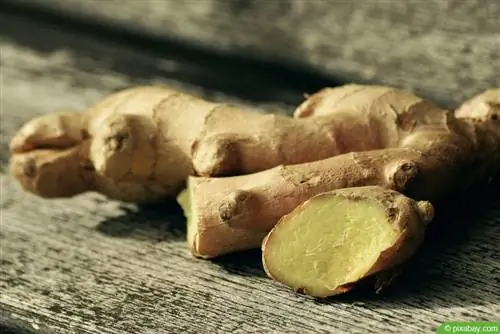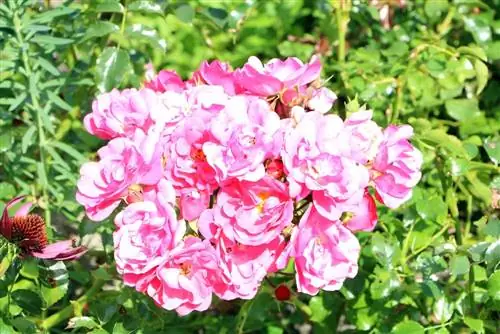- Author admin [email protected].
- Public 2023-12-17 03:39.
- Last modified 2025-01-24 12:45.
Potted roses are often given as gifts for Mother's Day or Valentine's Day, because the rose is the flowering plant with the greatest symbolic power. If cared for properly, they will last for years and offer wonderful flowering pleasure every year. Roses also thrive in window boxes and hanging baskets, especially varieties with a slightly drooping habit. This means you can create a pretty potted rose garden even in the smallest of spaces. However, potted roses need a little more attention than their sisters in the garden. They simply have more demands so that they feel really comfortable.
Location
The potted roses, like the roses in the garden, require a sunny, airy location. Partial shade is still fine as long as they get at least half a day of sun. However, they should be spared from the midday heat. Because then nutrient and water reserves run out very quickly. If necessary, move the potted roses to a suitable place on the terrace.
Planting substrate
Rose soil or commercial standard soil is best for potted roses. It contains all the important trace and main nutrients for the first six weeks. You can also mix the plant substrate yourself from compost, mineral fertilizer and finely ground lime. The substrate should be nice and loose and not clump together.
vessel selection
Potted roses are usually sold in normal pots. However, roses have a taproot that extends deep into the ground. In a normal pot shape, their roots cannot fully develop. That is why it is advisable to choose a cylindrical shape. There are special rose pots available in stores in different sizes with the corresponding cylindrical shape.
Tip:
For dwarf roses, containers with a diameter of 25 centimeters or more are sufficient. For larger rose classes it should be at least 30 to 40 centimeters in diameter. The pots should always be so large that the root ball still has 10 centimeters of space on all sides of the container up to the container wall.
Material for the vessels
When choosing the right container for your potted rose, your own taste plays an important role, as well as the appropriate size and practical properties. However, the different materials all have their advantages and disadvantages.
Glazed clay pots
Due to the high temperatures during firing and the glaze, the clay hardly absorbs any water. If handled correctly, the vessels are well frost-resistant.
Plastic pots
In bright sun or frost, these pots offer the roses little protection, even if the pots are weatherproof and easy to transport.
Rustic natural materials such as willow and wood
These containers must be lined with foil on the inside before you fill in soil and place the plants. Always cut a hole in the foil.
Metal pots
Metals absorb a lot of heat. That's why you have to regularly make sure that the plant substrate doesn't dry out.
Terracotta pots
These pots are very heavy. However, their warm Mediterranean look is popular with many hobby gardeners. Only high-quality pots and tubs are frost-proof.
Tip:
No matter which container you prefer, they should all have a drainage hole in the bottom so that excess water can drain away easily.
Planting
- best planting time in spring
- Water the root ball of the rose well before planting
- Short the roots a little with sharp pruning shears
- Place the potsherd on the trigger hole
- fill in a layer of gravel
- put a piece of fleece on top
- Mix rose soil with some horn shavings (long-term fertilizer effect)
- fill in some soil
- Hold the rose at the right height
- The finishing point must be approx. five centimeters below the substrate surface
- continue to fill in soil around the root ball
- Press the soil well and water it
Tip:
To make it a little easier for you when watering, the substrate surface should be approx. two fingers wide below the edge of the container.
Watering and fertilizing

Roses love an evenly moist substrate that is regularly watered with soft water from spring to autumn. To suppress evaporation somewhat, you can add a layer of colorful pebbles, shells or empty snail shells to the surface of the substrate. This is not only practical, but also looks pretty. You can use slow-release fertilizer or even liquid rose fertilizer, depending on how you like it or how you have time to fertilize. Fertilize with liquid fertilizer weekly until mid-July. Long-term fertilizer saves you work and can be put into the soil as a fertilizer cone once in the spring.
Wintering
Since the roots of potted roses are more exposed to the cold in winter than the roots of garden roses, they also need to be wrapped better. Roses in pots survive the winter without any problems as long as they freeze slowly and thaw slowly again in peace. Therefore, insulate the vessels well with a 10 centimeter thick layer of burlap, bubble wrap or similar material. Then place the containers in a place protected from sun and wind in front of a house wall. Small pots can also be placed in a mortar bucket or similar container that leaves about 10 centimeters of space to the wall of the container for frost protection materials such as leaves, Styrofoam or wood shavings. To prevent water from stagnating, the planters, like the containers for the potted roses, must have a drainage hole.
Cutting
Cut the dead flowers from your potted rose at least once a week to encourage flower formation. This means you will be able to enjoy your rose for longer. If you like and take the time to do it, you can also clean out the potted roses with regular watering or every day. Especially in cooler, damp weather, it is important to cut off the withered flowers so that they do not become moldy. Potted roses, like their big sisters, should be cut every year. The best time is in spring when the forsythia is blooming. Dwarf roses are given a hemispherical shape and are cut back to 10 to 15 centimeters so that they can grow well again. Blind shoots, i.e. shoots that do not have flower buds, can be cut down to two to three well-developed leaves all year round.
Diseases and pests
Pestted roses are also often troubled by animal pests. In addition, mildew and sooty mold sometimes occur. You can use natural remedies from your own “garden pharmacy” to combat fungal diseases, provided you leave nettles or horsetail in a specific place in your garden to use them for teas, broths and manures.
Field horsetail broth: Add 150 g dried or 1 kg fresh herb to 1 liter of water, dilute 1:10 for later use.
Stinging nettle broth: Add 150 g dried or 1 kg fresh herb to 10 liters of water, dilute 1:10 for later use.
You can also buy homeopathic plant tonics from specialist retailers, which are increasingly being used by hobby gardeners.
The following also help with aphids etc.: Seed extract from neem tree seeds, rapeseed oil
Beautiful dwarf rose varieties
Yellow flowers
Calina:
- large, light yellow, semi-double flowers in clusters
- rich and often flowering
- Growth height 60 to 80 centimeters
- Width 60 to 80 centimeters
- broadly bushy to overhanging
Sun Child:
- deep golden yellow, medium-sized, double flowers in clusters
- abundant and often flowering
- Growth height 35 centimeters
- Width 30 centimeters
- well-branched, upright growth
Red flowers
Dwarf King 78:
- bright blood-red, medium-sized, loosely double flowers
- rich and often flowering
- Growth height 50 centimeters
- Width 40 centimeters
- compact, upright, bushy growth
Pink flowers
Pepita:
- Flower color strong pink to carmine pink
- long-lasting, small flowers in clusters
- abundant and often flowering
- Growth height 50 centimeters
- Width 50 centimeters
- upright, well-branched growth
Planting combinations
If you use large troughs or pots, you can combine the dwarf roses with the following flowering plants that get along well with them:
- True to men (Lobelia)
- Purple bells (Heucheria)
- Ornamental sage (Salvia)
- Elfspur (Diascia)
- Bluebells (Campanula)
Conclusion
Potted roses are true patio princesses with lush blooms if you give them some attention. With long-term fertilizer and good drainage in the pot, you can ensure a good start to the rose year. And in winter, simply wrap your rose up nice and snuggly so that it can bring you joy again next year with its wonderful flowers.






